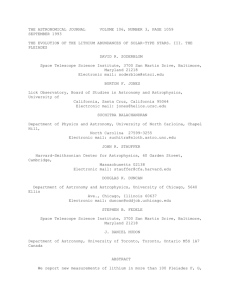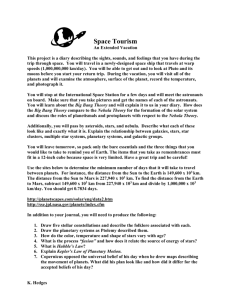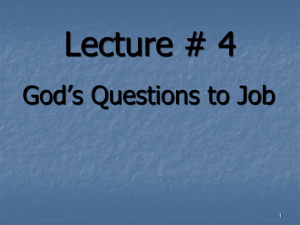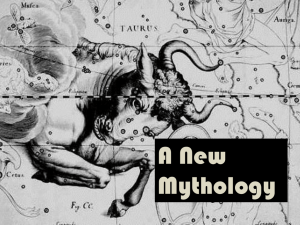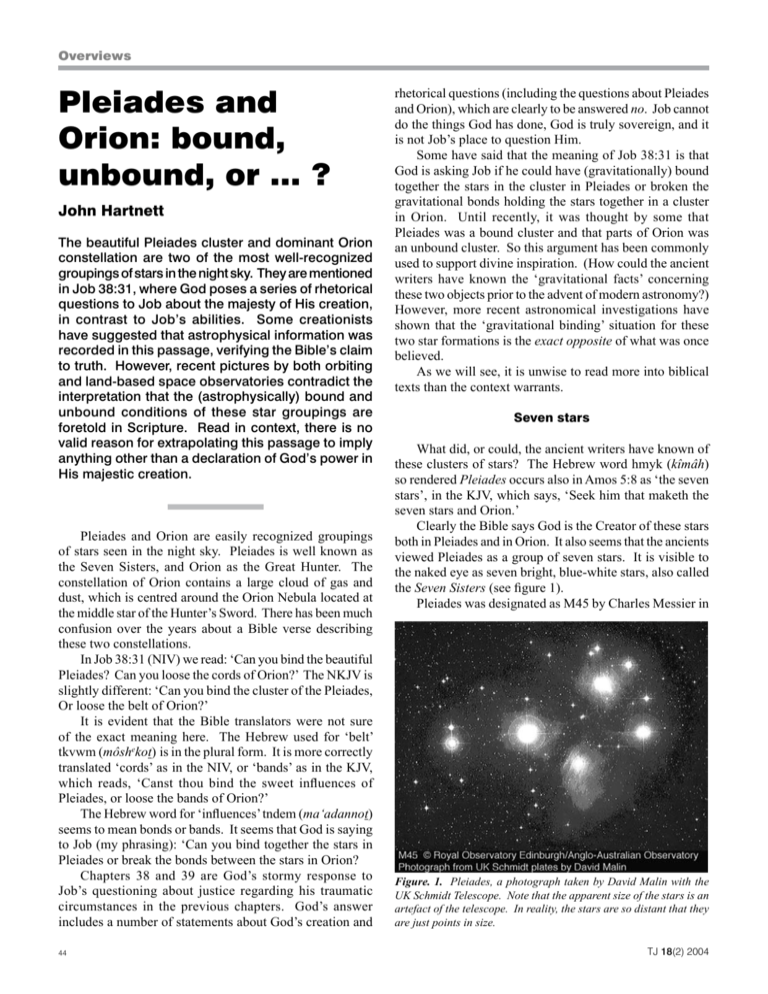
Overviews
Pleiades and
Orion: bound,
unbound, or … ?
John Hartnett
The beautiful Pleiades cluster and dominant Orion
constellation are two of the most well-recognized
groupings of stars in the night sky. They are mentioned
in Job 38:31, where God poses a series of rhetorical
questions to Job about the majesty of His creation,
in contrast to Job’s abilities. Some creationists
have suggested that astrophysical information was
recorded in this passage, verifying the Bible’s claim
to truth. However, recent pictures by both orbiting
and land-based space observatories contradict the
interpretation that the (astrophysically) bound and
unbound conditions of these star groupings are
foretold in Scripture. Read in context, there is no
valid reason for extrapolating this passage to imply
anything other than a declaration of God’s power in
His majestic creation.
Pleiades and Orion are easily recognized groupings
of stars seen in the night sky. Pleiades is well known as
the Seven Sisters, and Orion as the Great Hunter. The
constellation of Orion contains a large cloud of gas and
dust, which is centred around the Orion Nebula located at
the middle star of the Hunter’s Sword. There has been much
confusion over the years about a Bible verse describing
these two constellations.
In Job 38:31 (NIV) we read: ‘Can you bind the beautiful
Pleiades? Can you loose the cords of Orion?’ The NKJV is
slightly different: ‘Can you bind the cluster of the Pleiades,
Or loose the belt of Orion?’
It is evident that the Bible translators were not sure
of the exact meaning here. The Hebrew used for ‘belt’
tkvwm (môshekot) is in the plural form. It is more correctly
translated ‘cords’ as in the NIV, or ‘bands’ as in the KJV,
which reads, ‘Canst thou bind the sweet influences of
Pleiades, or loose the bands of Orion?’
The Hebrew word for ‘influences’ tndem (ma‘adannot)
seems to mean bonds or bands. It seems that God is saying
to Job (my phrasing): ‘Can you bind together the stars in
Pleiades or break the bonds between the stars in Orion?
Chapters 38 and 39 are God’s stormy response to
Job’s questioning about justice regarding his traumatic
circumstances in the previous chapters. God’s answer
includes a number of statements about God’s creation and
44
rhetorical questions (including the questions about Pleiades
and Orion), which are clearly to be answered no. Job cannot
do the things God has done, God is truly sovereign, and it
is not Job’s place to question Him.
Some have said that the meaning of Job 38:31 is that
God is asking Job if he could have (gravitationally) bound
together the stars in the cluster in Pleiades or broken the
gravitational bonds holding the stars together in a cluster
in Orion. Until recently, it was thought by some that
Pleiades was a bound cluster and that parts of Orion was
an unbound cluster. So this argument has been commonly
used to support divine inspiration. (How could the ancient
writers have known the ‘gravitational facts’ concerning
these two objects prior to the advent of modern astronomy?)
However, more recent astronomical investigations have
shown that the ‘gravitational binding’ situation for these
two star formations is the exact opposite of what was once
believed.
As we will see, it is unwise to read more into biblical
texts than the context warrants.
Seven stars
What did, or could, the ancient writers have known of
these clusters of stars? The Hebrew word hmyk (kîmâh)
so rendered Pleiades occurs also in Amos 5:8 as ‘the seven
stars’, in the KJV, which says, ‘Seek him that maketh the
seven stars and Orion.’
Clearly the Bible says God is the Creator of these stars
both in Pleiades and in Orion. It also seems that the ancients
viewed Pleiades as a group of seven stars. It is visible to
the naked eye as seven bright, blue-white stars, also called
the Seven Sisters (see figure 1).
Pleiades was designated as M45 by Charles Messier in
Figure. 1. Pleiades, a photograph taken by David Malin with the
UK Schmidt Telescope. Note that the apparent size of the stars is an
artefact of the telescope. In reality, the stars are so distant that they
are just points in size.
TJ 18(2) 2004
Overviews
© Association of Universities for Research in Austronomy Inc. (Aura), all rights
reserved. AURA/NOAO/NSF.
Pleiades and Orion: bound, unbound, or … ? — Hartnett
Figure 2. Image of Pleiades, M45, taken with the 0.9-m telescope
of Kitt Peak National Observatory, in 1975. At Pleiades’ distance of
about 400 light-years, the image field of view corresponds to a linear
diameter of 20 light-years.
his first list of nebulae and star clusters, published in 1771.
On a clear night the Pleiades can be easily seen about 10
degrees north-west of the bright red-giant star Aldebaran.
This group of stars, which numbers many more than is
visible to the naked eye, is approximately 380 light-years
from Earth.1 They are mentioned three times in the Bible,
by Hesiod between 1000 and 700 bc and by Homer in his
Odyssey. Quoting from a web source:
‘The Pleiades are among those objects which
are known since the earliest times. At least 6
member stars are visible to the naked eye, while
under moderate conditions this number increases
to 9, and under clear dark skies jumps up to more
than a dozen (Vehrenberg, in his Atlas of Deep Sky
Splendors, mentions that in 1579, well before the
invention of the telescope, astronomer Moestlin
has correctly drawn 11 Pleiades stars, while Kepler
quotes observations of up to 14. Burnham points
out that the name ‘Pleiades’ may be derived from
either the Greek word for ‘to sail’, or the word
‘pleios’ meaning “full” or “many”.’2
About 1846, the German astronomer Mädler
noticed that the stars of Pleiades had no measurable proper
motion relative to each other or with the star Alcyone in
the centre of the group (i.e. they are all moving in the same
direction). Groups of stars that move together are called a
cluster. Modern astronomy has shown that the constituent
stars of Pleiades are expected to dissociate within the next
250 million years,3 and hence Pleiades is an open or unbound
cluster. That is, the motions and velocities of its constituent
objects are such that the gravitational forces between them
are not sufficient to hold it together (as a recognizable
cluster) over the longer term.
A ‘bound’ cluster, by contrast, can be shown to still be
TJ 18(2) 2004
a recognizable grouping even if its motions are projected
forward by a billion years or so. Throughout this paper I
use the words ‘bound’ and ‘unbound’ defined as follows. A
bound cluster is in virial equilibrium4 and will not dissipate
or break apart given any amount of time. An unbound
cluster is the opposite. The mutual gravitational forces
between the constituents are insufficient, over time, to
prevent the cluster’s dissipation due to the relative motions
of its members.
Modern astronomy has revealed that more than 500
mostly faint stars belong to the Pleiades star cluster, spread
over a region about four times the diameter of the moon
(as seen from Earth). The density of the cluster is low,
compared to other galactic clusters, and longer-exposure
photographs show the Pleiades to be embedded in nebulous
material (figures 1 and 2). Pleiades is a large but expanding,
or unbound, cluster of stars that are all just passing the same
region of space at the same time with the same motion.
Figure 3 shows an image5 of the Pleiades cluster taken
by the Rosat X-ray telescope from space. Clearly there
are many more stars than the optical images show. X-ray
images reveal the true extent of the cluster.
Orion’s Belt
Many people recognize the three stars known as Orion’s
Belt, which are pictured in fig. 4 in the centre of the Orion
constellation. The NKJV of Job 38:31 apparently refers to
these three stars. It uses the word ‘belt’ but is that possibly the
result of a reliance on man’s knowledge to translate the text?
The Orion Nebula, also named M42, is an emission
Figure 3. Rosat image of Pleiades in X-rays. The optically brightest
stars are indicated by the squares. The brightest X-ray stars are
those with the hottest atmospheres. Credit: Thomas Preibisch.
<www.xray.mpe.mpg.de/>, <www.mpe.mpg.de/>.
45
Overviews
Pleiades and Orion: bound, unbound, or … ? — Hartnett
other famous objects such as Barnard’s Loop, the Horsehead
Nebula and the reflection nebula M78. The Orion Nebula
itself is an impressive sight both in visible and infrared light.
It covers an area of the sky four times the size of the full
Moon and has a linear diameter of about 30 light-years. The
initial identifications of the Orion Nebula apparently ‘got
lost’ for some time, so that eventually Christian Huygens
was credited for his independent rediscovery in 1656, e.g.
by Charles Messier when he added it to his catalogue on
4 March, 1769.5
Trapezium Cluster
Visible light: NASA, O’Dell, C.R. and Wong, S.K.
Infrared: NASA, Luhman, K.L. et al.
If we look more closely into the core region of the Orion
Nebula we may see a small group of stars exciting most of
the visible nebulosity. The set of four optically visible stars
at the core of the nebula forms the Trapezium. The stars
Figure 4. The Orion Nebula (M42) centred around the middle ‘star’
in this region are known to be luminous X-ray sources.7 A
(Theta Orionis) of Orion’s Sword. The smaller nebula at the top (M43)
few stars can be made out in the visible spectrum (figure
is considered to be part of the Orion Nebula separated by darker
5–A). But if we look at the image taken with infrared light
material. (Photo by David Malin).
(figure 5–B), which is able to penetrate the dusty regions,
we see a beautiful cluster of stars that was hidden from
and reflection nebula. Nicholas-Claude Fabri de Peiresc
view. The Trapezium lies at the front surface of a massive,
was likely the first to identify the Nebula, in 1610. The
dusty molecular cloud. The Trapezium stars, labelled ‘A’,
Jesuit astronomer Johann Baptist Cysatus of Lucerne also
‘B’ and ‘C’, were first described by Christian Huygens in
independently identified it in 1611. Located at a distance
1656 when he independently rediscovered the Orion Nebula.
of around 1,300 light-years from Earth, the Orion Nebula
The fourth, or ‘D’, was first found by Abbé Jean Picard in
is the brightest diffuse nebula in the sky and visible to the
1673, and later independently by Huygens in 1684.
naked eye under good conditions.6 It is very easy to find as
Near-infrared photons escape the dusty Orion molecular
it surrounds the Theta Orionis multiple star in the middle
cloud much more easily than optical photons, enabling
of the Sword of Orion.
detection of hundreds of stars embedded within the cloud
The Orion Nebula is the main part of a much larger
core that lies just behind the Trapezium. Since the opacity of
cloud of gas and dust extending across the night sky over
a typical molecular cloud to 1 keV photons is approximately
10 degrees, taking in over half the constellation of Orion
the same as the dust opacity of such a cloud at 2 microns, it
is assumed that the cloud is dominated by dust. In 1998, it
(figure 6). The cloud’s linear extent is over several hundred
was claimed that NASA’ s Hubble Space Telescope, while
light-years. It contains the Orion Nebula near its centre and
probing deep within the Trapezium
cloud, uncovered a swarm of brown
dwarf stars. The HST’s near-infrared
A
B
camera revealed about 50 of these
objects throughout the Orion Nebula’s
Trapezium Cluster.8
It was further claimed that it is a
region of star birth, a star nursery:
‘… 300 fledgling stars and
brown dwarfs surround the brightest,
most massive stars in Hubble’s view
of the Trapezium Cluster’s central
region. All of the celestial objects
in the Trapezium were born together
in this hotbed of star formation. …
The Hubble telescope’s near-infrared
camera, the Near Infrared Camera
and Multi-Object Spectrometer,
Figure 5. The central region of the Orion Nebula where the Trapezium Cluster is found. penetrated those clouds to capture
a view of those objects. The brown
The left image is in visible light and the right image is in infrared.
46
TJ 18(2) 2004
Overviews
Copyright Suen Kohle and Till Credner.
dwarfs are the faintest objects in the image.
Surveying the cluster’s central region, the Hubble
telescope spied brown dwarfs with masses equalling
10 to 80 Jupiters.’5
In fact, no star formation was observed. Such
claims are based on computer simulations. What was observed were very-low-mass, dim stars, which were emitting
a lot of infrared as well as X-rays. There are seemingly
insurmountable problems with models of stellar formation,
which counter these claims, but that is beyond the scope of
this article.
Figure 7 shows an X-ray image of about a thousand Xray-emitting stars in the Orion Nebula star cluster (ONC),
taken by the Chandra X-Ray Observatory.9 The X-rays
are produced in the very-high-temperature atmospheres of
these stars. These are the stars illuminating all the dust in
the Orion Nebula. This image (figure 7) corresponds to a
region of about 10 light-years across. The bright stars in
the centre are part of the Trapezium. This image clearly
reveals a very tightly bound cluster. The Orion Trapezium
Cluster is a subgroup of stars at the core of the ONC confined
within a radius of about 1.5 light-years. It has been argued
by some that the infrared-imaged cluster (figure 5-B) is
another cluster behind the Trapezium Cluster and that the
ONC is fostering a double cluster system.
Figure 6. The constellation of Orion. M42 and M43 (in the the
middle of Orion's Sword hanging from his belt) are part of a larger
cloud that includes the horsehead nebula (located adjacent to the
left-most star of Orion's belt) and Barnard’s loop (the cresent shaped
cloud on the left).
TJ 18(2) 2004
Photo by NASA/PSU.
Pleiades and Orion: bound, unbound, or … ? — Hartnett
Figure 7. Chandra X-Ray Observatory image of M42. The dark
vertical and horizontal lines, and the streaks from the brightest stars,
are instrument effects.
The naturalistic formation of bound star clusters is a
major unsolved problem in observational and theoretical
astrophysics. Significant resources, both theoretical and
observational, are being directed at solving this problem.
But serious technical difficulties remain. Kroupa10 has
modelled birth scenarios for some young, compact, binaryrich clusters and has found possible birth models leading to
the Orion Nebula Cluster (ONC), of which the Trapezium
Cluster is the core. He found a narrow range of solutions,
which allow the ONC to be in virial equilibrium, expanding
or contracting. This means that the ONC is a gravitational
bound cluster, even though it may be expanding or
contracting. Also for a group of stars to be located in a
region of space with only a radius of 1.5 light-years, it would
seem they are gravitationally bound.
The HST and Chandra have both taken very clear images
of the four bright primary stars that form the Trapezium (and
others that are not so bright). They can be seen in figure 8,
in visible light overlaid with X-ray images. The Lord has
created but also hid from view, until now, a tightly bound
cluster of stars in Orion behind the Trapezium.
Conclusion
What was originally thought to be bound is unbound
and what was thought to be unbound is bound (given current
astrophysical definitions). In this paper ‘bound’ describes
a gravitationally stable state and ‘unbound’ describes a
collection of stars that are mutually passing the same point
in space but are not gravitationally tied together. What can
be made of all this? Creationists need to be careful not to
read into the text more than is appropriate. In context, God’s
47
Overviews
Pleiades and Orion: bound, unbound, or … ? — Hartnett
written’ (1 Corinthians 4:6).
References
1. This was recently determined by direct parallax measurement by ESA’s
astrometric satellite Hipparcos.
2. <http://www.seds.org/messier/m/m045.html>, 15 March 2004.
Photo by NASA/CXC/SAO. J Bolly, CASA Colorado.
3.
Figure 8. Overlay of optical (HST) and X-ray (Chandra) images of
the Trapezium.
questioning of Job is rhetorical, aimed at clearing up any
question of God’s sovereignty. This passage is not teaching
about cosmology—in contrast to Gen. 1:14–18, where God
is clearly stating when He made the sun, moon and stars.
The text in Job 38:31 and 32 describes real astronomical
bodies in poetical language. Making cosmological
assertions about such poetical texts (as opposed to the
clearly historical narrative of Genesis 1) is not wise. In the
past, some have used this passage in Job to claim biblical
accuracy in relation to the universe. As pointed out earlier,
it was argued that God was asking Job if he can do the same
as God, while now we could turn the argument around and
suggest that God is asking Job if he can undo what God has
done (though this would not be consistent with the rhetorical
negative answers of the other questions).
Such rubbery interpretations should be a warning to
us of poor exegesis. There is no reason to think that the
Job passage has anything to do with the minutiae of the
gravitational forces and motions within each cluster. The
passage is perfectly understandable from Job’s perspective,
as a reflection on God’s sovereignty in establishing and
controlling the positions and motions of the heavenly
bodies, period.
The verse in Job following the one about Pleiades
and Orion states: ‘Can you bring forth the constellations
in their seasons or lead out the Bear with its cubs?’ If we
insist that the Pleiades/Orion passage is about bound and
unbound clusters, what is to be made of leading out the Bear
(Arcturus [KJV])? Again this makes sense if one realizes
it is being used to make a powerful point about God’s
sovereignty—not teaching specifics about astrophysics.
Truly ‘the heavens declare the Glory of God’ (Psalm 19:1);
however, we must be careful not to ‘go beyond what is
48
Meynet, G., Mermilliod, J.-C. and Maeder, A., New dating of galactic
open clusters, Astron. Astrophys. Suppl. Ser. 98, pp. 477–504, 1993.
4. A state where a cluster is in a dynamic equilibrium. The virial theorem
states that, for a stable, self-gravitating distribution of objects (stars,
galaxies, etc.), the time-averaged total kinetic energy of the objects is
equal to minus half the time-averaged total gravitational potential energy.
Energy may shift between gravitational potential energy and kinetic energy
for the individual objects but the time-averaged values of the total potential
and total kinetic energies of the system remain constant. The constituents
will never break up unless acted upon my outside forces. The positions
and velocities of the constituents are bounded for all time.
5. <www.seds.org/messier/more/m045_more.html>.
6. <www.seds.org/messier/m/m042.html>.
7. <http://space.mit.edu/ASC/science/orion/orion.html>.
8. <www.seds.org/messier/more/m042_h5.html>.
9. <www.seds.org/messier/more/m042_cxo.html>.
10. Kroupa, P., Constraints on stellar-dynamical models of the Orion Nebula
Cluster, New Astron. 4:615–624, 2000.
John G. Hartnett received both his B.Sc. (hons) (1973) and
his Ph.D. with distinction (2001) from the Department of
Physics at the University of Western Australia (UWA). He
currently works as an ARC Post-Doctoral Fellow with the
Frequency Standards and Metrology research group there.
His current research interests include ultra low-noise radar,
ultra high stability microwave clocks based on pure sapphire
resonators, tests of fundamental theories of physics such as
Special and General Relativity and measurement of drift in
fundamental constants and their cosmological implications.
He has published more than 40 papers in refereed scientific
journals and holds 2 patents.
TJ 18(2) 2004



